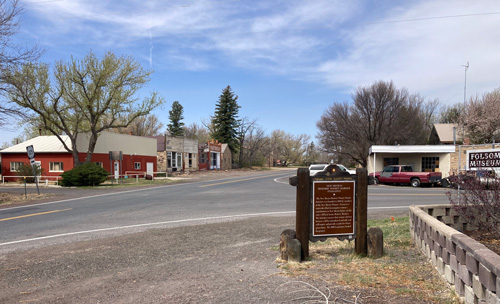Folsom Points and Footprints in the Sand
Contact
University of Arkansas System Division of Agriculture
Cooperative Extension Service
2301 S. University Ave.
Little Rock, AR 72204

Folsom Points and Footprints in the Sand

I’ve been out for a week now following the route of the Santa Fe Trail from Missouri to New Mexico. It took travelers in the 1830s eight weeks to make the crossing, but I did it in a little more than a week, even with some of my off-trail trips. One of these was to scratch a long-standing itch — to see Folsom, New Mexico, the small town where the Folsom point was discovered.
The Folsom points, some of the oldest spear points found in North America, are back in the news again because of some footprints discovered in southern New Mexico at the White Sands National Park. Interestingly, these footprints push the arrival of humans in the Americas back about 10,000 years, the same amount the Folsom points pushed back the estimated arrival time a century ago.
That humankind originated in Africa is well established. For the past several hundred years archaeologists and scientists from a number of related fields have been working to fill in the gaps in knowledge about all things human. Central amongst these is to better understand our evolution and distribution around the globe to make it a cohesive and believable tale.
At the close of the 19th century, the oldest known artifacts found in the Americas were believed to only be about 3,000 years old. Granted, at that time modern techniques of dating were wanting and the opinion of just an expert or two could establish a wild guess as fact. Then, in August of 1908 there came a mighty flood on the Cimarron River which has its headwaters in the valleys above Folsom.
A few weeks after the flood the foreman of Crowfoot Ranch, a man named George McJunkin, a former slave who had educated himself about nature, noticed some bones about ten feet below the surface sticking out of a wash created by the flood. He dug a few out and decided they were bison bones, but not the bison bones he had seen strewn over the western prairies after the great buffalo extermination efforts of the 1880s.
McJunkin mentioned his find to others, and over the next 20 years a wider and wider circle of amateur archaeologists and museum curators became involved in studying the site. Finally, about four years after McJunkin’s death, a team completely excavated the site in 1926 and discovered a broken spear point embedded in the vertebra of an extinct species of bison.
Eventually 32 bison skeletons were removed from the site along with another embedded spear point and several adjacent fluted Folsom points scattered amongst the bones. Experts in the field, primarily because they weren’t involved in the discovery, tried to discount the importance of the find, but eventually the significance of the site was recognized. In 1929, a slightly older kind of fluted spear point was discovered near Clovis, New Mexico, that was primarily associated with mammoth kills. When all the data were studied, it was determined humans had been in North America at least 13,000 years.
But in September 2021, a team of scientists announced the discovery of hundreds of fossilized human footprints that were first reported in 2009, but the shifting sands made keeping track of them difficult. Using radio-carbon dating of some seeds embedded in a footprint, they dated the footprints as being around 23,000 years old.
The new discovery throws into question more assumptions about the arrival of humans in the Americas. The Folsom and Clovis points fit nicely with the theory that people migrated from Siberia as the last Ice Age began its retreat about 13,000 years ago. But, 23,000 years ago our continent was near its glacial maximum, so how did the earliest peoples get here if their entry point was buried in thousands of feet of ice?
So, the questions continue. Over the years I’ve attended a number of lectures exploring possible avenues of migration into the Americas and none have felt quite right to me. I personally like the idea that perhaps there were multiple points of entry into the New World and at different times. Now it will just take a few spectacular discoveries to suss out this possibility.